Famous Abstract Art and Primary Color Red and Posted in Past Week
Abstract Fine art, which originated in the late nineteenth century, was an incredibly versatile fine art menses made up of a diversity of genres. Some of the types included Abstract Expressionism, Lyrical Abstraction, Color Field Painting, Post-painterly Abstraction, and Minimalism. Abstract Art emerged due to the want of artists to create artworks that were completely contained to and unrestrained past visual references that occurred in real life. Thus, art pieces embodied the multiple changes that were taking identify in society, technology, and scientific discipline at the time.
Table of Contents
- 1 An Introduction to Abstract Painting
- 2 The Ten Well-nigh Famous Abstract Art Pieces
- 2.1 Wassily Kandinsky: Untitled (Outset Abstract Watercolor) (1910)
- ii.2 Piet Mondrian: Tableau I (1921)
- 2.three Paul Klee: Senecio (1922)
- two.4 Joan Miró: Peinture (Etoile Bleue) (1927)
- 2.5 Pablo Picasso: Nude, Greenish Leaves and Bust (1932)
- ii.half dozen Ben Nicholson: 1934 (relief) (1934)
- 2.7 Jackson Pollock: Convergence (1952)
- two.viii Helen Frankenthaler: Mountains and Sea (1952)
- 2.9 Mark Rothko: No. 2, Greenish, Red and Bluish (1953)
- 2.ten Robert Motherwell: Elegy to the Spanish Commonwealth No. 110 (1971)
An Introduction to Abstract Painting
Seen as a non-representational art movement, abstraction within art adult tremendously throughout the years, with many artists choosing to experiment within this genre. Thought to arise during the late 19th century and early 20th century, Abstract Art opposed traditional representation fine art, as information technology aimed to conduct no resemblance to anything remotely distinguishable in the natural world.
Abstruse Art arose as artists attempted to create works that were completely unrelated to any perceptible references, to the point where artworks became completely detached from reality birthday. Most artists in the early 20thursday century sought new ways of producing art, with Abstract Art existing every bit a medium that evoked the notion of being entirely abstracted from something real.
This was because reality at the fourth dimension, with all of its many changes, was thought to exist incredibly restricting and artists felt a need to suspension away from its limitations.
Brainchild was firmly established as a major strength within the fine art world as society began to experience depression, food shortages, and war. Artists began to depict these concepts of what was seen in society through non-realistic and symbolic artworks, which demonstrated a not bad departure from traditional and representative artistic creation. The evolution of Abstruse Art gave artists the autonomy needed to create endless boundaries in lodge to put together their theoretical compositions and label them every bit "art".
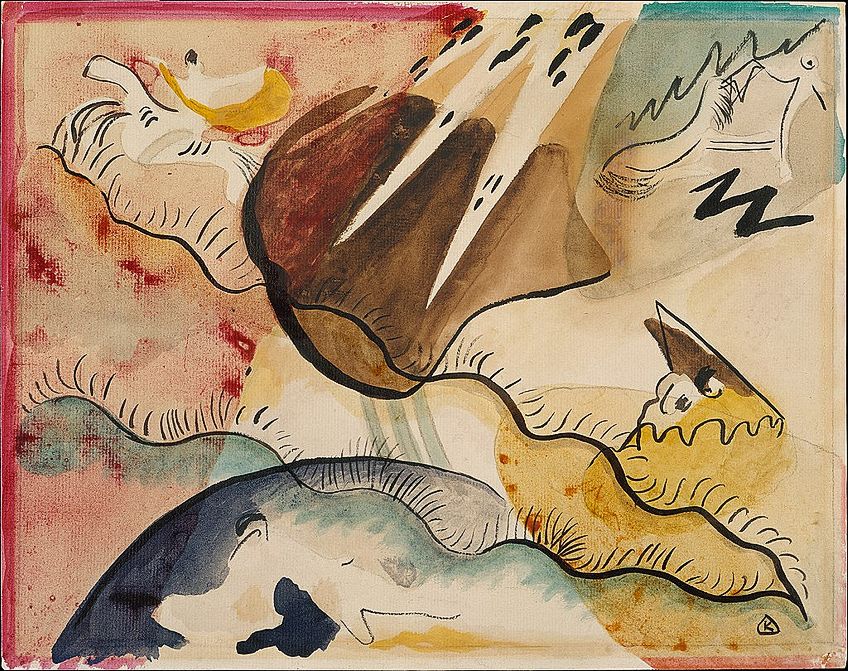 Rain Mural (1911) by Wassily Kandinsky;Wassily Kandinsky, CC0, via Wikimedia Eatables
Rain Mural (1911) by Wassily Kandinsky;Wassily Kandinsky, CC0, via Wikimedia Eatables
This freedom in art was characterized by an unrestrained use of color, shapes, forms, and gestural marks, which were combined to reach an unusual aesthetic, which led to intense emotional responses from viewers. The result of these artworks was that they became greatly abstracted, with this style said to represent the creative person's thoughts and emotions when creating the artwork. Therefore, Abstract Art was believed to conjure up powerful emotions and connections with viewers through the images that were depicted.
Artworks created were thus in retaliation to the fundamental changes that were occurring in the technological, scientific, and philosophical spheres of the Western European world, with Abstruse Fine art existing as the major turning signal in artistic society.
Due to this, no right or wrong way existed when it came to interpreting Abstract Fine art and what information technology meant, as the motility embodied the idea that whatever depictions could exist classified as art.
Ane of the well-nigh iconic Abstract Artists of all fourth dimension was Wassily Kandinsky, who was said to pigment the beginning and most iconic Abstruse artwork ever made. Since the cosmos of Kandinsky's artwork, the Abstract Art movement proved to exist an extremely multifaceted field that encouraged an investigation and evolution of new styles and techniques, that take since influenced the emergence of other fine art movements today.
The Ten Most Famous Abstruse Art Pieces
Throughout the early xxth century, a lot of famous Abstruse art was created, with the majority of these artworks still being spoken about today. When considering these Abstruse Art examples, certain artworks take managed to stand out and proceeds increasing popularity every bit time has gone on. While there are many more artworks that can be included when considering the most famous Abstract paintings of all time, nosotros have called the ten all-time Abstract paintings to talk most below.
Wassily Kandinsky: Untitled (First Abstruse Watercolor) (1910)
Thought to be the pioneer of Abstract Art, Russian artist Wassily Kandinsky was easily recognized every bit the most iconic member of the unabridged movement. Nicknamed the "father of Abstruse Art", Kandinsky painted some of the primeval works within the genre, including what was said to be the first truthful artwork of the Abstract Art menstruation. The artwork in question, which he painted in 1910, was his Untitled (First Abstract Watercolor).
| Creative person | Wassily Kandinsky (1866 – 1944) |
| Date Painted | 1910 |
| Medium | Watercolor and Indian ink and pencil on paper |
| Dimensions | 49.6 cm x 64.8 cm (19.5 in ten 25.5 in) |
| Where It Is Currently Housed | Centre Georges Pompidou, Paris |
Kandinsky expressed a want to suspension away from the constraints of including subject matter within artworks, with Untitled demonstrating elements and techniques that were unique to the new genre of Abstract artwork was developing. Characterized by vivid colors and gestural smears, Kandinsky prioritized the expression of intense emotions over an accurate depiction of reality within his painting.
Working with watercolors, Kandinsky was able to complete this painting in just three days. However, despite his haste, Kandinsky made various studies for this artwork before beginning the final composition. What added to the speed that can exist interpreted within Untitled was his color pick, as Kandinsky artfully picked colors that he knew would faithfully correspond his emotions at the time. The lines and shapes that were fatigued likewise add to and emphasize the chaos and urgency that is experienced when viewing this painting.
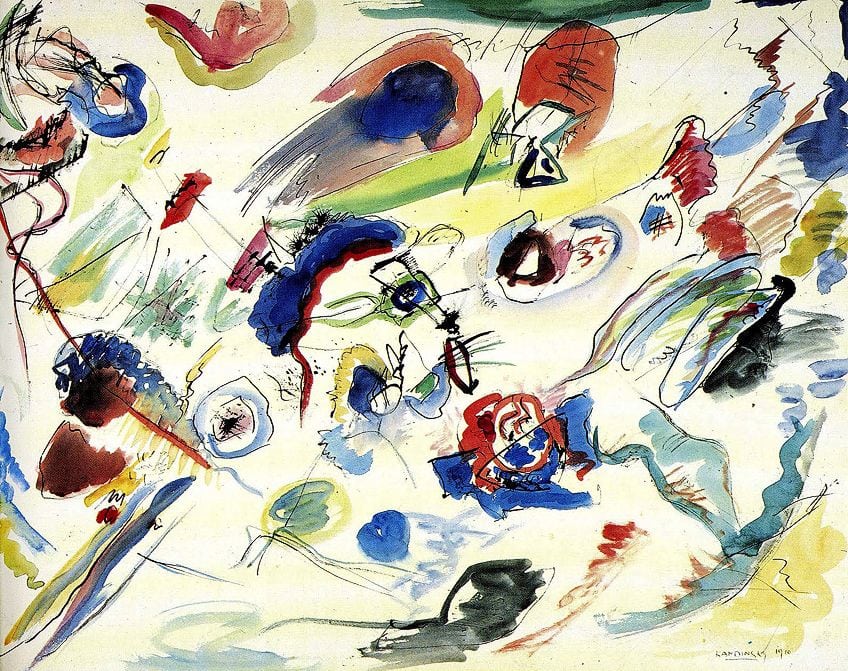 Untitled (Get-go Abstract Watercolor) (1913) past Wassily Kandinsky;Wassily Kandinsky, Public domain, via Wikimedia Eatables
Untitled (Get-go Abstract Watercolor) (1913) past Wassily Kandinsky;Wassily Kandinsky, Public domain, via Wikimedia Eatables
Abstraction is also clearly demonstrated inside this artwork through the loose and vague lines depicted, which triggered considerable interest from the creative crowd at the time. Untitled exists as an of import instigator of the Abstract Art movement, as it was the very first time that anything remotely discrete and unrestrained was accepted as a suitable discipline matter within artworks at the time. Untitled marked a defining point within European art equally the departure from traditional artworks towards more abstracted and uninhibited art pieces.
The period between 1910 and 1914 was considered to be Kandinsky's career summit and the summit of his greatest artistic achievements. Thus, Untitled existed equally ane of the get-go artworks that blatantly cast off all references to recognizable forms and emerged out of the constraints that were posed by the representational conventions of Western European painting.
This notion of complete freedom went on to feature prominently within the majority of the work created by Kandinsky during this flow.
Piet Mondrian: Tableau I (1921)
Iconic Dutch artist Piet Mondrian was another important figure within the Abstract Fine art movement, as he created some of the most iconic famous Abstract fine art pieces within the genre. Known for his involvement in both the Abstruse and De Stijl movements, Mondrian's art manner evolved significantly until information technology was eventually condensed into basic and simple geometric elements. His 1921 painting, titled Tableau I, demonstrates Mondrian's style well and exists as one of his most famous Abstruse paintings.
| Artist | Piet Mondrian (1872 – 1944) |
| Date Painted | 1921 |
| Medium | Oil on canvas |
| Dimensions | 103 cm ten 100 cm (twoscore.5 in 10 39.iii in) |
| Where Information technology Is Currently Housed | Kunstmuseum Den Haag, the Netherlands |
Through creating a painting that separated panels of paint by using solid black lines, Mondrian managed to solidify his well-known manner inside Abstract Art. This polished and harmonious balance that was created by the mathematic precision applied to compositions characterized the majority of Mondrian'southward artworks during this period, every bit he relied on firm and geometric shapes to have the place of recognizable figures.
In improver to this, Mondrian made use of solid blocks of colour and line in order to emphasize that no singled-out reference to annihilation was ever made within his artworks. The use of lines and color within Tableau I aided in the stark compartmentalization that Mondrian attempted to create between viewers and their minds when looking at this Abstract artwork.
This was done to highlight the notion that logical sense did not e'er accompany artworks, as some pieces tin but be understood and accepted as simple blocks of color, line, and form.
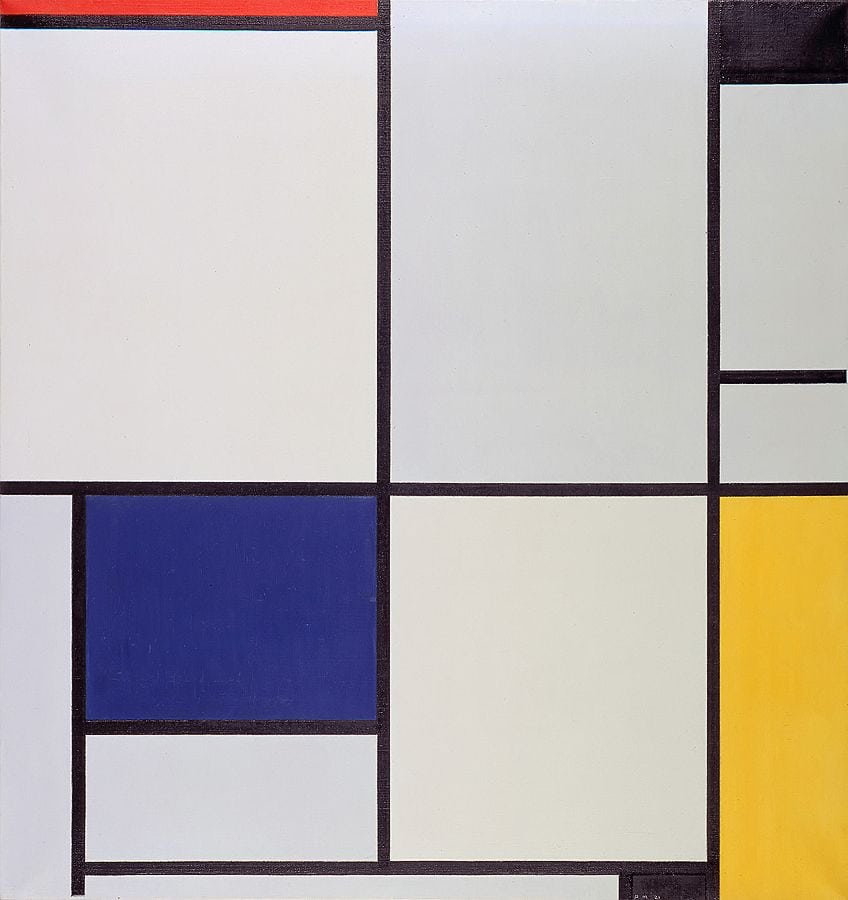 Tableau I(1921) by Piet Mondrian;Piet Mondrian, Public domain, via Wikimedia Commons
Tableau I(1921) by Piet Mondrian;Piet Mondrian, Public domain, via Wikimedia Commons
Equally seen within Tableau I, and other artworks during this menstruation, Mondrian merely made employ of master colors. His simplified color palette went on to display his utopian theory that the universe was merely an organic and balanced collection of objects and substances that could easily exist combined in geometric forms and lines.
By using just main colors, Mondrian made reference to the building blocks of all colors and was able to seamlessly create a sense of compositional harmony within his abstracted works, which is demonstrated within Tableau I. Mondrian accomplished a almost-perfect balance of color within Tableau I, with this Abstract artwork going on to influence an array of other artists, architects, and fashion designers inside popular art and contemporary fine art.
Paul Klee: Senecio (1922)
Another prominent artist within the Abstract Art era was German artist Paul Klee, whose paintings make up some of the best Abstract Fine art examples throughout history. Klee was as well known for his involvement inside Expressionism, Cubism, and Surrealism, as his great exploration of color theory stands out in the majority of his artworks. His most famous Abstract fine art slice, painted in 1922, is titled Senecio.
| Artist | Paul Klee (1879 – 1940) |
| Engagement Painted | 1922 |
| Medium | Oil on canvas mounted on panel |
| Dimensions | forty.5 cm x 38 cm (15.9 in x 15 in) |
| Where It Is Currently Housed | Kunstmuseum Basel, Switzerland |
Within Senecio, also known as Head of a Homo Going Senile, Klee depicts what appears to be a human head that has been divided into various rectangles of orange, yellowish, carmine, and white. The different squares of color are said to resemble a type of mask or patches traditionally worn by a harlequin, further unsaid by the reference to artist-performer Senecio in the artwork'south title.
Due to the abstraction created by the different squares, Senecio does not appear to draw a face at offset. However, when looking at the triangle and curved line seen above both eyes, it gives off the impression of raised eyebrows and viewers are then able to make out a face inside the blocks. The geometric precision in this work demonstrates quite a heavy Cubist influence, with this artwork considered to autumn role of both Cubism and Abstract Fine art.
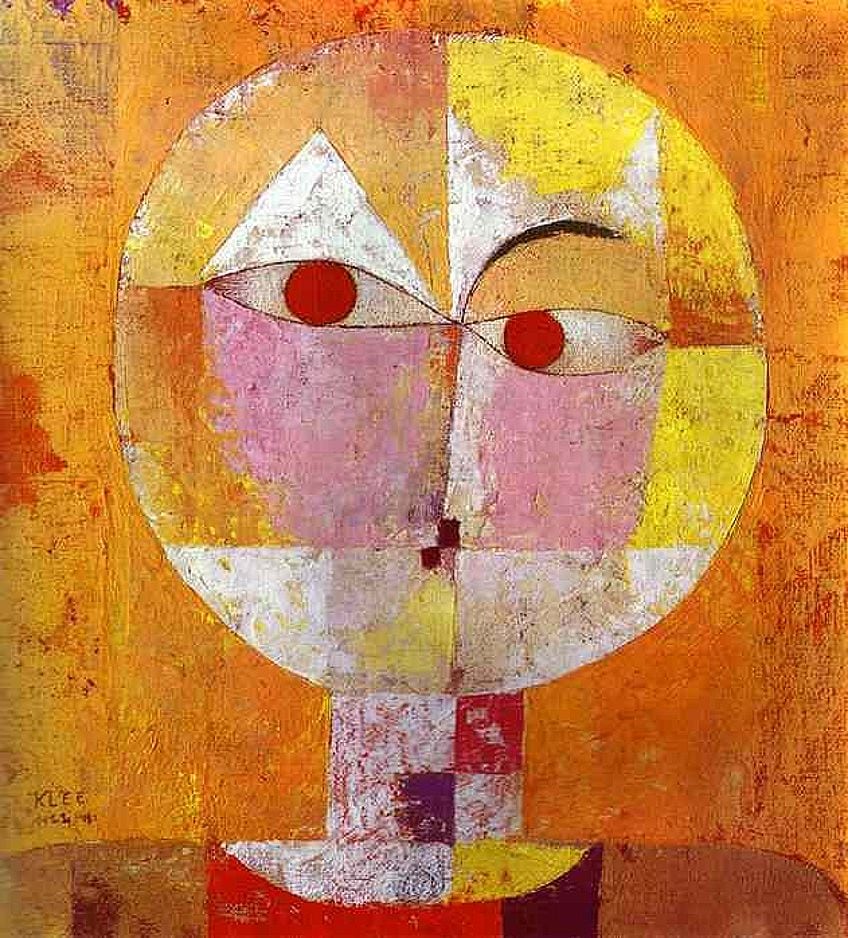 Senecio (Head of a Human) (1922) by Paul Klee;Paul Klee, Public domain, via Wikimedia Eatables
Senecio (Head of a Human) (1922) by Paul Klee;Paul Klee, Public domain, via Wikimedia Eatables
Through using simple colors and ambiguous shapes, Klee was able to dispense graphical elements to the point where they were able to form into a somewhat recognizable figure by the eye of viewers. Senecio also reveals Klee's sense of humor and interest in African culture, as the face has a mask-like quality to it.
The combination of colors, shapes, and illusion within Senecio demonstrates the shifting relationship that existed within the art world at the time, as the face up Klee portrayed had the power to hands shift into another form if viewers understood it differently. In addition to this theoretical notion, Senecio mocks paintings made by children, as the use of vague shapes and minimal facial details, like that in children's artworks, still manages to convey the figure Klee intended.
Joan Miró: Peinture (Etoile Bleue) (1927)
Spanish artist Joan Miró, who practiced primarily inside the Dada, Experimental, and Surrealist movements, likewise produced many famous Abstract paintings during his career. Despite being more closely linked to Surrealism, Miró painted several prominent artworks which were considered to be precursors to the development of Abstruse Art. One of these artworks, painted in 1927, was his Peinture (Etoile Bleue).
| Artist | Joan Miró (1893 – 1983) |
| Engagement Painted | 1927 |
| Medium | Oil on sheet |
| Dimensions | 115.5 cm x 89 cm (45 five/8 in 10 35 in) |
| Where It Is Currently Housed | Private collection |
What makes this artwork so interesting is that information technology documented Miró'south transition between Figurative and Abstract Fine art. Within this painting, it is difficult to discern what the actual subject area matter is at kickoff. Nonetheless, after viewing it for a few minutes, most viewers will remark that they may even so not quite empathise what it is that Miró is trying to correspond.
Painted with a scorching blue groundwork, the sparse black lines that seem to be doodles become clearer, as well as the two spots of bright blue and red. In the middle of the painting, in between the winding black lines, a splash of pinkish is shown. Despite this intersection of lines and flecks of color, no concrete images or representable figures are able to form, demonstrating the true abstraction present within this artwork.
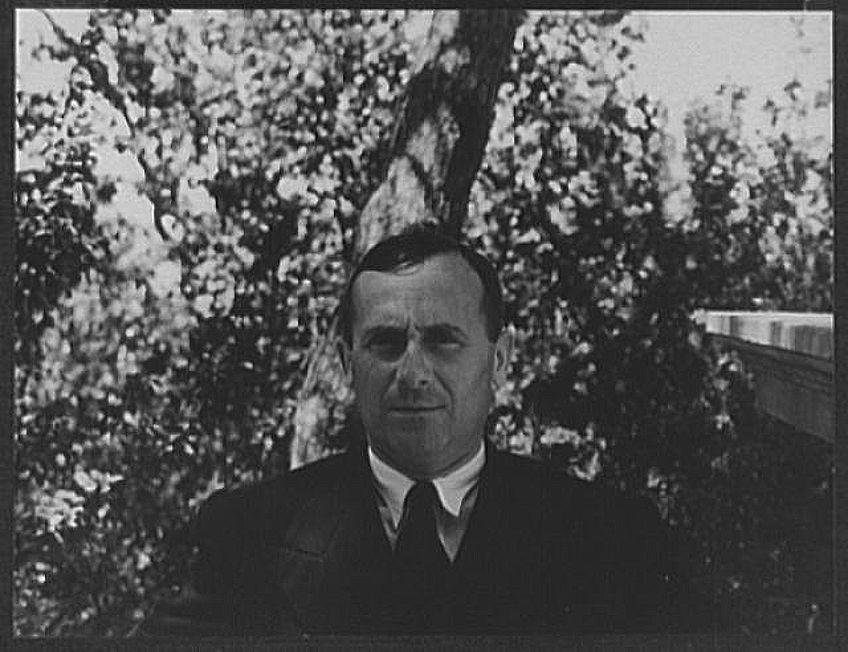 Portrait of Joan Miró in 1935;Carl Van Vechten, Public domain, via Wikimedia Commons
Portrait of Joan Miró in 1935;Carl Van Vechten, Public domain, via Wikimedia Commons
Within Peinture (Etoile Bleue), Miró was able to create an extraordinary prototype of visual potency, with this artwork taking on a dreamlike feeling. Miró dubbed the intensity of the blue within this painting as the "color of [his] dreams", further demonstrating the phantasmagorical and surreal feeling that tin be felt when viewing this artwork.
Miró claimed that when he painted, he but painted the images he saw in his caput.
This statement emphasized that fact that visually recognized references could not always be found inside his paintings, as the subject affair he depicted was taken from his own listen. As a Surrealist artist, Miró often painted while hallucinating and nether the influence of drugs. Peinture (Etoile Bleue), while existing as a famous Abstract art piece in its own right, was thus a product of Miró's irrational approach to art creation.
The colors used within Miró's artwork, in particular the hit bluish, went on to influence other Abstract painters such as Mark Rothko and Yves Klein. In improver to its great touch on, Miró's Peinture (Etoile Bleue) went on to go the almost expensive painting of his that ever sold, fetching £23.5 million in 2012.
Pablo Picasso: Nude, Greenish Leaves and Bust (1932)
1 of the most iconic painters within art history, in general, is Spanish artist Pablo Picasso. Throughout his lengthy career, Picasso experimented predominantly within the Cubist and Surrealist movements. In add-on to this, he created some artworks that were considered to be office of the Abstract Art period every bit well. Out of all the works he created, ane of his best Abstract Fine art paintings was thought to exist Nude, Dark-green Leaves and Bust, painted in 1932.
| Artist | Pablo Picasso (1881 – 1973) |
| Date Painted | 1932 |
| Medium | Oil on canvas |
| Dimensions | 162 cm x 130 cm (64 in x 51 in) |
| Where It Is Currently Housed | Currently on long-term loan to the Tate Mod, England |
Within Nude, Green Leaves and Bust, Picasso painted his mistress at the time, Marie-Thérèse Walter. Picasso idea of Walter as his muse, with this portrait existence dedicated to her and the neat affect that she had on him. Standing over a meter alpine, this Abstruse artwork includes a representation of Walters every bit a slightly simplified and abstracted figure lying in front of a vibrant blue curtain. She appears to be surrounded by seemingly random objects, including a plant, a bust sitting atop a plinth, and some fruit.
This stunning masterpiece represented the sensuous relationship that Picasso had with Walters. For years, he kept their human relationship a secret from his wife, with this air of mystery and privacy being implied by the bathetic effigy in the painting and the inclusion of a drape. In painting Walters this way, Picasso was able to further shield her identity in addition to creating a course that was initially disruptive for viewers to make logical sense of.
Nude, Green Leaves and Bust exists every bit a notable example of Abstruse Fine art, as the techniques and elements used by Picasso demonstrate that it was somewhat removed from reality. This is emphasized by the confusion surrounding the objects that are shown, as well as the concealment of the figure's confront.
Primary colors are used in the background, which illustrates the compositional harmony that was created through the use of these colors, referencing the technique fabricated famous by fellow artist Piet Mondrian.
Thus, Nude, Dark-green Leaves and Bust exists as an important artwork within Abstract Art, every bit Picasso managed to seamlessly contain elements from other styles into this unique painting. It too broke the globe tape for the most expensive painting ever sold at the time, as it was auctioned at $106.5 meg in 2010. Today, Nude, Light-green Leaves and Bust holds the price tag for the third-highest price ever attached to a piece of artwork on auction.
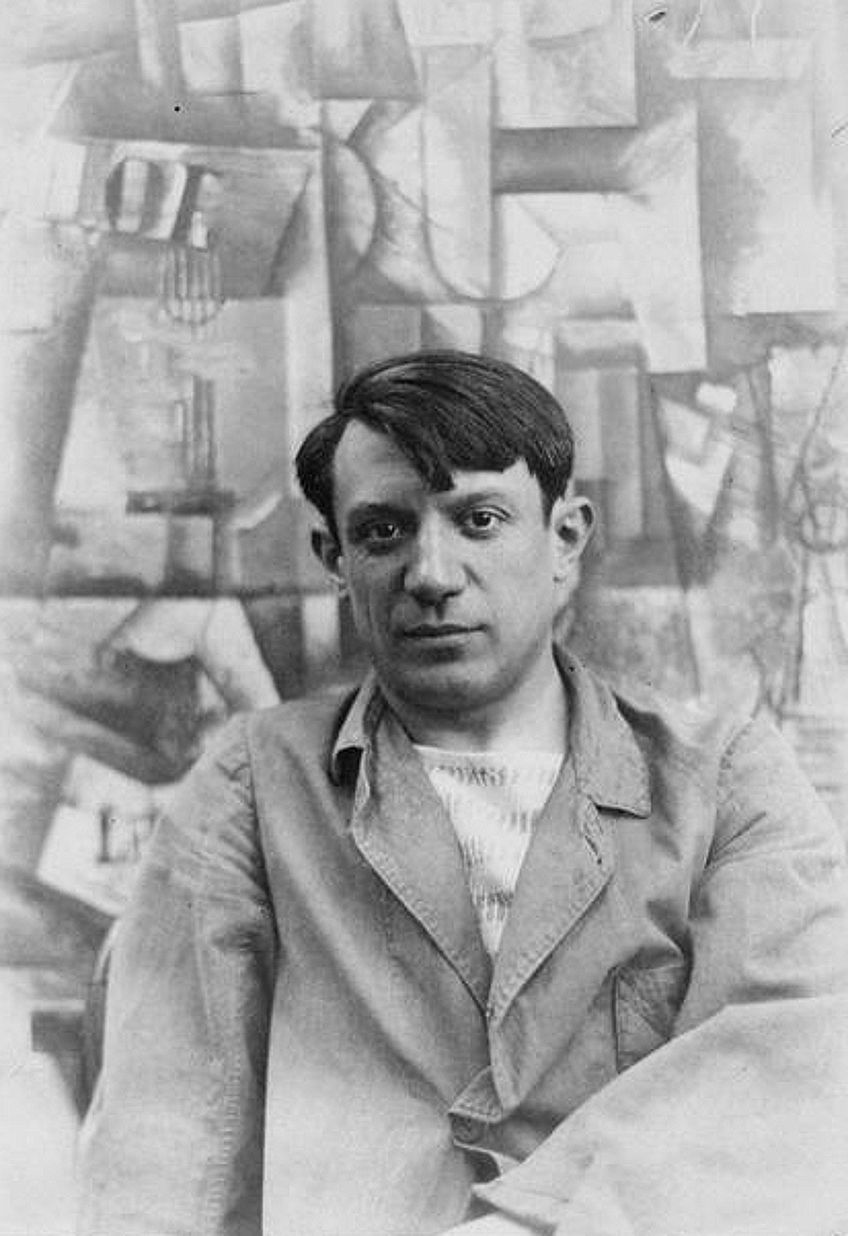 Portrait photograph of Pablo Picasso in forepart of his painting The Aficionado (Kunstmuseum Basel) at Villa les Clochettes, Sorgues, France, summer 1912;Anonymous Unknown writer, Public domain, via Wikimedia Commons
Portrait photograph of Pablo Picasso in forepart of his painting The Aficionado (Kunstmuseum Basel) at Villa les Clochettes, Sorgues, France, summer 1912;Anonymous Unknown writer, Public domain, via Wikimedia Commons
Ben Nicholson: 1934 (relief) (1934)
Another prominent creative person within the Abstract Fine art period was British artist Ben Nicholson. Working exclusively in Abstract compositions, landscapes, and still lives, Nicholson'southward artworks have been said to make upwardly some notable Abstruse Art examples. One of Nicholson's artworks, created in 1934, is his 1934 (relief) artwork.
| Artist | Ben Nicholson (1894 – 1982) |
| Date Painted | 1934 |
| Medium | Oil pigment on mahogany |
| Dimensions | 71.8 cm ten 96.5 cm |
| Where It Is Currently Housed | Tate Modern, England |
Heavily inspired by the Postal service-Impressionist and Cubist movements, Nicholson was intrigued at how paintings could potentially stand for space. He began to wander away from his traditionally figurative style so equally to get-go experimenting and producing what he believed to exist abstract reliefs. In these abstract and geometrically sculpted artworks, Nicholson hand-fabricated each piece before painting them white.
Inside 1934 (relief), Nicholson was greatly influenced by the artworks of Piet Mondrian after meeting him, also as boyfriend artists Joan Miró and Alexander Calder. In this Abstract artwork, Nicholson demonstrated his avoidance of color as he chose to paint in pure white. Created in the years earlier World War Two bankrupt out, 1934 (relief) existed as a subtle exploration of the turbulent menstruum that was experienced between both wars through the vast abstraction and lack of color used.
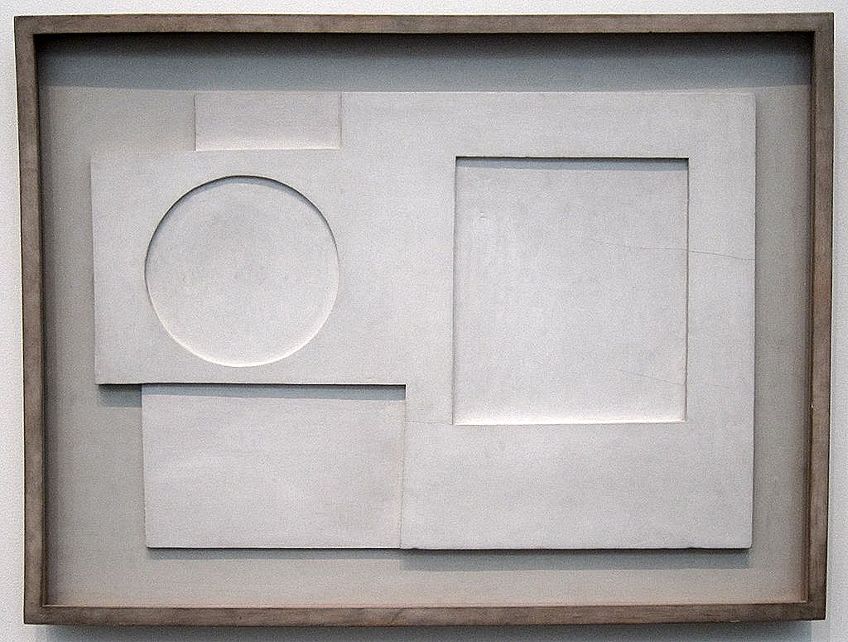 1934 (relief) oil paint on woods sculpture by Ben Nicholson, 1934, Tate Modern; sculpture: en:Ben Nicholson (d 1982); photo: Wmpearl, CC0, via Wikimedia Commons
1934 (relief) oil paint on woods sculpture by Ben Nicholson, 1934, Tate Modern; sculpture: en:Ben Nicholson (d 1982); photo: Wmpearl, CC0, via Wikimedia Commons
Through etching out a circle and a square from a wooden board, Nicholson demonstrated the idea of "defective" within society at the fourth dimension. In 1934 (relief), all emotion is removed through the inclusion of geometric forms, the dimensional layering, and the monochromatic color palette used.
This artwork established Nicholson as one of the virtually important figures within English Abstraction at the time, as he went on to create a series of these abstruse white sculptural reliefs in this unique style.
Jackson Pollock: Convergence (1952)
An artist who was primarily associated with the Abstract Expressionist movement was American painter Jackson Pollock. Seen every bit a major figure within that movement, Pollock created many famous Abstract art pieces throughout his career, every bit he was said to have produced an impressive 363 paintings while he was alive. One of his best Abstract paintings, created in 1952, is his Convergence artwork.
| Artist | Jackson Pollock (1912 – 1956) |
| Appointment Painted | 1952 |
| Medium | Oil on canvas |
| Dimensions | 237 cm 10 390 cm (93.five in x 155 in) |
| Where It Is Currently Housed | Albright-Knox Fine art Gallery, New York |
In addition to being one of his earliest Abstruse artworks, Convergence is widely considered to be Pollock's nigh admired and mettlesome piece ever made. Known for his infamous drip-painting technique, Pollock demonstrated this style within Convergence, as the painting depicts a collage made up of splattered colors that seem to form into expertly skilled shapes and lines. These elements are able to evoke quite intense emotions from viewers while simultaneously attacking the eye, equally the immense size of Convergence is a lot to take in.
Within Convergence, little $.25 of life can be seen on the surface of Pollock'southward work. He included objects like nails and coins, as well every bit a pocket-sized match which can be seen in the center of the artwork. Originally creating this painting with a monochromatic colour palette, Pollock was unhappy with the issue and decided to add bits of colour in order to save the Abstract artwork. While critics may take initially debated if his addition of color succeeded in salvaging the artwork, Convergence exists equally ane of Pollock'due south most well-known works today.
Existing as a personification of free speech every bit well as freedom of expression, the disrespect of Convergence near dares viewers to slightly disagree with its message. Convergence managed to limited opinions of the threat of Communism and the Russian Cold State of war through the unique style that was used.
Thus, information technology is considered to exist an important and innovative painting inside history, as the message attached to Pollock'south artwork described everything America stood for at that time.
Due to its colossal size, Convergence is best appreciated in person. Considering of its popularity, a jigsaw visitor released a 340-piece puzzle of Convergence in 1964 and advertised it equally "the world's about difficult puzzle" at the fourth dimension. Due to this marketing, countless Americans went to purchase the puzzle, which further solidified Pollock's prominence within the art earth, as well as the bear upon of Convergence on society.
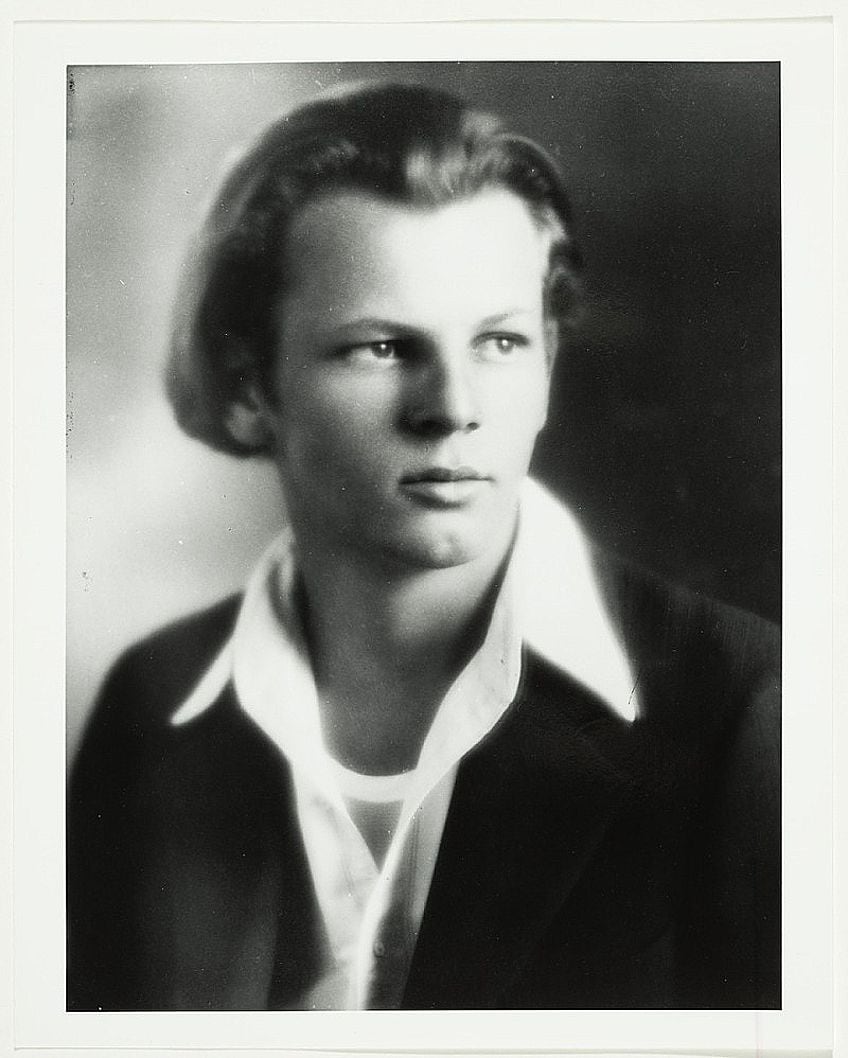 Portrait of Jackson Pollock in 1928;Smithsonian American Art Museum, Public domain, via Wikimedia Commons
Portrait of Jackson Pollock in 1928;Smithsonian American Art Museum, Public domain, via Wikimedia Commons
Helen Frankenthaler: Mountains and Sea (1952)
An of import female artist within the Abstract Fine art motility was American painter Helen Frankenthaler, who was one of the but artists to span the several generations of all Abstruse painters. Her Abstruse Art paintings were ever-changing, which demonstrated her developing style within the period. One of her most famous Abstruse art pieces, painted in 1952 when she was just 23 years erstwhile, was Mountains and Body of water.
| Artist | Helen Frankenthaler (1928 – 2011) |
| Date Painted | 1952 |
| Medium | Oil and charcoal on canvas |
| Dimensions | 220 cm x 297.8 cm (87 in x 117.2 in) |
| Where Information technology Is Currently Housed | National Gallery of Art, Washington D.C. |
Within this artwork, Frankenthaler was celebrated for her unique soak-stain technique, in which she thinned her oil paints with turpentine or kerosene before using them to stain the unprimed canvas. This led to the paint being absorbed by the unprepared canvas, which gave her works a sense of constant movement. After viewing some of Jackson Pollock'southward monochromatic drip works in 1951, Frankenthaler was inspired to create her own distinctive technique in the artworks she produced, which led to the development of soak-staining.
Later a trip to Nova Scotia, Frankenthaler was inspired past the scenery she saw to exam out her new technique for the outset time. Mountains and Bounding main demonstrated an well-nigh translucent depiction of bathetic forms thought to represent mountains, which gave her artwork an elusive-like aureola. By using her soak-stain technique, Frankenthaler'due south painting took on organic configurations that implied great tranquility, with her light and pastel color palette calculation to the heavenly and transient nature of her work.
Based on the effect of Frankenthaler'due south technique, Mountains and Ocean is considered to be 1 of the first successful Color Field Paintings to be inside Abstruse Expressionism and has remained one of the movement's most appealing images today. Frankenthaler's famous Abstract art pieces went on to influence numerous artists experimenting inside the genre, equally her light and flowy technique allowed a polish release from the popular impasto technique that dominated painting at the fourth dimension.
Mountains and Body of water was Frankenthaler's first professionally exhibited Abstract artwork of her career. In addition to this, her artwork is also i of her largest paintings ever fabricated. Despite its immense size, Mountains and Sea was able to capture a quiet intimacy that Frankenthaler experienced when in Nova Scotia, with her soft color choices of pink, blue, and green adding to the luminous yet transparent quality of the watery figures and shapes she depicted.
Its size, in conjunction with the colors used, essentially allowed her depictions to float off the canvas.
Mark Rothko: No. ii, Light-green, Red and Bluish (1953)
An important pioneer of Color Fields Painting within the Abstract Art genre was Russian-American artist Mark Rothko. All-time known for the bright apply of colour within his artworks, Rothko'due south artworks exist as notable Abstruse Fine art examples due to a significant lack of subject matter in nigh of his paintings. One of his notable paintings, which he painted in 1953, is Rothko's No. two, Green, Scarlet and Blue.
| Artist | Marker Rothko (1903 – 1970) |
| Appointment Painted | 1953 |
| Medium | Oil on canvas |
| Dimensions | 205.vii cm x 170.five cm (81 in x 67.1 in) |
| Where It Is Currently Housed | Private collection |
The colors used within No. ii, Light-green, Cherry-red and Bluish demonstrate Rothko's fascination with creating washed canvases made out of just 3 colors, which went on to get his signature style. As depicted inside this artwork, as well as in Rothko'southward numerous other famous Abstruse paintings, he relied on creating grids that were able to squarely fit blocks of solid color that often contrasted with i some other.
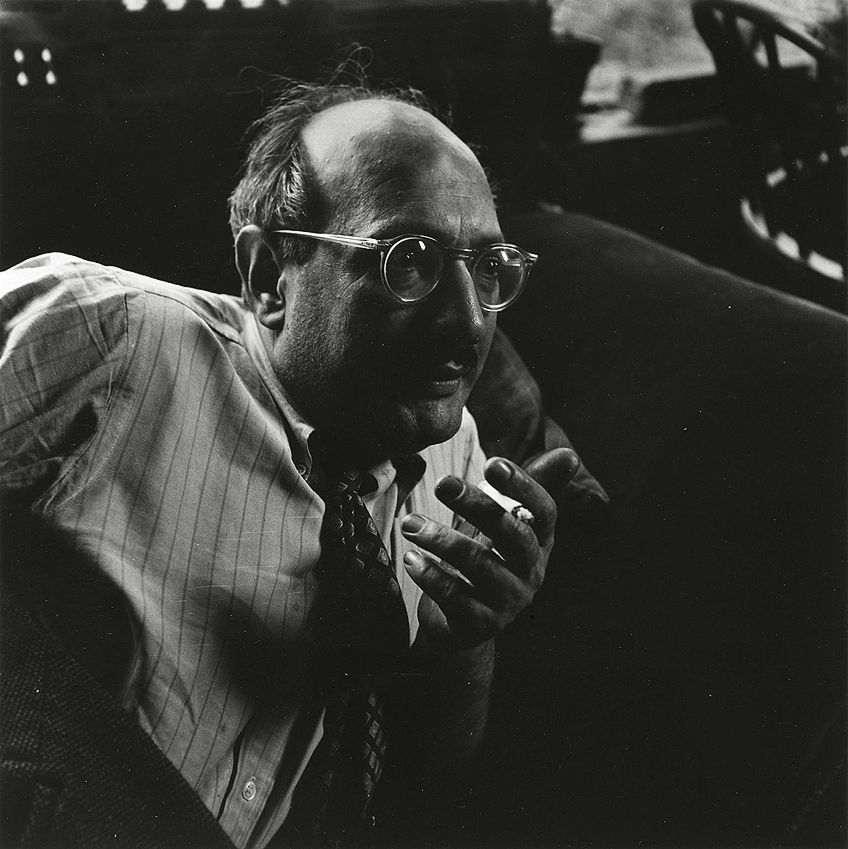 Mark Rothko, Yorktown Heights, ca. 1949;Consuelo Kanaga, No restrictions, via Wikimedia Commons
Mark Rothko, Yorktown Heights, ca. 1949;Consuelo Kanaga, No restrictions, via Wikimedia Commons
Within No. 2, Light-green, Blood-red and Blueish, the expression of color exists as the main discipline in the painting. Rothko chose colors that accurately depicted his emotional country at the fourth dimension, with the bright hues of ruby, green, and blue depicting a lighter energy. Withal, as his career progressed, Rothko'southward mental wellness was said to drastically decline, which led to him making use of more somber tones such as blacks, grays, and dejection within his paintings. No. 2, Dark-green, Cerise and Blue was the artwork that marked the transition betwixt his light and nighttime stage.
Through the careful use of color, Rothko is able to conjure up intense emotions inside his Abstract Fine art paintings.
In this artwork, the red band in the centre of the painting contrasts heavily with the blue block while complementing the dark-green section of the piece of work. Rothko believed the utilise of color was able to tap into basic human emotions and thus bring about a variety of different meanings in viewers when because his artworks. The lighter tones inside No. 2, Green, Ruby-red and Blue were thought to signify a more peaceful fourth dimension in his life.
Robert Motherwell: Elegy to the Spanish Republic No. 110 (1971)
The terminal painter on our list is American artist Robert Motherwell, who was well-known throughout the Abstract Expressionist movement. Motherwell was considered to be the about articulate artist within the movement, as his Abstract artworks touched on many pertinent issues regarding politics, philosophy, and literary themes. Ane of his famous Abstruse art pieces, painted in 1971, was titled Elegy to the Spanish Republic No. 110.
| Creative person | Robert Motherwell (1915 – 1991) |
| Date Painted | 1971 |
| Medium | Acrylic with graphite and charcoal on sail |
| Dimensions | 208.3 cm x 289.half-dozen cm (82 in 10 114 in) |
| Where Information technology Is Currently Housed | Solomon R. Guggenheim Museum, New York |
Within this artwork, Motherwell was said to shake up the world of Brainchild, as his painting included very key and rugged gestures which simultaneously conveyed feelings of strength, energy, and anxiety. The stark use of black and white in this painting unsaid a deep understanding of life and death, which added a stoic blazon of force to this artwork.
The subject field matter, which this painting is believed to be based on, was the Spanish Civil War that broke out in 1936.
Although Motherwell was only 21 years onetime at the time, the atrocities that he witnessed would proceed to greatly affect him in the years to come up. Based on this, the intensity within his painting brings forth profound and heavy emotions when viewing the artwork. In improver to this painting, Motherwell created a series of more than 200 other paintings which responded to the Castilian Civil War.
The sense of pure freedom within this artwork added to the level of abstraction that Motherwell used in his artwork. Inside Elegy to the Spanish Democracy No. 110, this abstraction served as a memorialization of human suffering and the unrelenting circumvolve of life and death.
The furious type of energy in Elegy to the Spanish Republic No. 110 completely surrounds viewers when looking at the artwork, as the gestural and fundamental brushstrokes seem to burst correct off the canvas. Motherwell's artwork contains a strange sense of anxiety, which adds to the striking vitality that is present in the painting. At a time where Abstraction seemed to exist fading away, Motherwell inserted a vigorous new life force into the style, which has gone on to inspire Abstract artists to this very day.
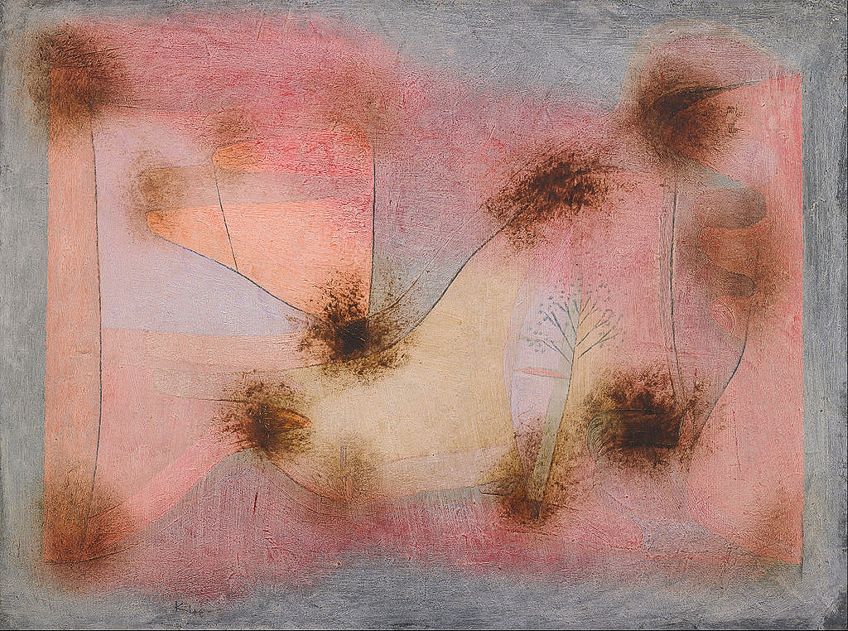 Hardy Plants (1934) by Paul Klee, oil on pulpboard;Paul Klee, Public domain, via Wikimedia Commons
Hardy Plants (1934) by Paul Klee, oil on pulpboard;Paul Klee, Public domain, via Wikimedia Commons
Abstruse Art held a powerful influence over the direction of artistic creation. Some of the world's most famous Abstract art pieces were created during this catamenia and are however highly revered today. While we have only included ten of the best Abstract Art examples here, we encourage you to explore this genre further if you lot have enjoyed learning most these unique and exceptional artworks.
Accept a await at our Abstruse paintings webstory here!
Source: https://artincontext.org/famous-abstract-paintings/
0 Response to "Famous Abstract Art and Primary Color Red and Posted in Past Week"
Post a Comment